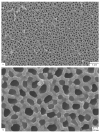Nanoporous membranes for medical and biological applications
- PMID: 20049818
- PMCID: PMC3684197
- DOI: 10.1002/wnan.50
Nanoporous membranes for medical and biological applications
Abstract
Synthetic nanoporous materials have numerous potential biological and medical applications that involve sorting, sensing, isolating, and releasing biological molecules. Nanoporous systems engineered to mimic natural filtration systems are actively being developed for use in smart implantable drug delivery systems, bioartificial organs, and other novel nano-enabled medical devices. Recent advances in nanoscience have made it possible to precisely control the morphology as well as physical and chemical properties of the pores in nanoporous materials that make them increasingly attractive for regulating and sensing transport at the molecular level. In this work, an overview of nanoporous membranes for biomedical applications is given. Various in vivo and in vitro membrane applications, including biosensing, biosorting, immunoisolation, and drug delivery, are presented. Different types of nanoporous materials and their fabrication techniques are discussed with an emphasis on membranes with ordered pores. Desirable properties of membranes used in implantable devices, including biocompatibility and antibiofouling behavior, are discussed. The use of surface modification techniques to improve the function of nanoporous membranes is reviewed. Despite the extensive research carried out in fabrication, characterization, and modeling of nanoporous materials, there are still several challenges that must be overcome in order to create synthetic nanoporous systems that behave similarly to their biological counterparts.
Copyright (c) 2009 John Wiley & Sons, Inc.
Figures





Similar articles
-
Nanochannels: biological channel analogues.IET Nanobiotechnol. 2012 Jun;6(2):63-70. doi: 10.1049/iet-nbt.2011.0033. IET Nanobiotechnol. 2012. PMID: 22559709 Review.
-
Micromachined biocapsules for cell-based sensing and delivery.Adv Drug Deliv Rev. 2004 Feb 10;56(2):211-29. doi: 10.1016/j.addr.2003.08.014. Adv Drug Deliv Rev. 2004. PMID: 14741117 Review.
-
Synthetic vs Natural: Diatoms Bioderived Porous Materials for the Next Generation of Healthcare Nanodevices.Adv Healthc Mater. 2017 Feb;6(3). doi: 10.1002/adhm.201601125. Epub 2016 Dec 27. Adv Healthc Mater. 2017. PMID: 28026914 Review.
-
Gyroid nanoporous membranes with tunable permeability.ACS Nano. 2011 Oct 25;5(10):7754-66. doi: 10.1021/nn200610r. Epub 2011 Sep 14. ACS Nano. 2011. PMID: 21866958
-
Porous polymeric membranes: fabrication techniques and biomedical applications.J Mater Chem B. 2021 Mar 11;9(9):2129-2154. doi: 10.1039/d0tb01727b. J Mater Chem B. 2021. PMID: 33283821 Review.
Cited by
-
Photo-responsive nanoporous liquid crystal polymer films for selective dye adsorption.RSC Adv. 2024 Jan 2;14(2):863-871. doi: 10.1039/d3ra06791b. eCollection 2024 Jan 2. RSC Adv. 2024. PMID: 38174275 Free PMC article.
-
Fabrication of Hybrid Membranes Containing Nylon-11 and Organic Semiconductor Particles with Potential Applications in Molecular Electronics.Polymers (Basel). 2019 Dec 19;12(1):9. doi: 10.3390/polym12010009. Polymers (Basel). 2019. PMID: 31861628 Free PMC article.
-
New, Fully Implantable Device for Selective Clearance of CSF-Target Molecules: Proof of Concept in a Murine Model of Alzheimer's Disease.Int J Mol Sci. 2022 Aug 17;23(16):9256. doi: 10.3390/ijms23169256. Int J Mol Sci. 2022. PMID: 36012525 Free PMC article.
-
Microfluidic anodization of aluminum films for the fabrication of nanoporous lipid bilayer support structures.Beilstein J Nanotechnol. 2011;2:104-9. doi: 10.3762/bjnano.2.12. Epub 2011 Feb 11. Beilstein J Nanotechnol. 2011. PMID: 21977420 Free PMC article.
-
Short-Pulse Lasers: A Versatile Tool in Creating Novel Nano-/Micro-Structures and Compositional Analysis for Healthcare and Wellbeing Challenges.Nanomaterials (Basel). 2021 Mar 12;11(3):712. doi: 10.3390/nano11030712. Nanomaterials (Basel). 2021. PMID: 33809072 Free PMC article. Review.
References
-
- Wisniewski N, Reichert M. Methods for reducing biosensor membrane biofouling. Colloids and Surfaces B: Biointerfaces. 2000 Oct;18(11–12):197–219. - PubMed
-
- Andrade JD, Hlady V. Protein adsorption and materials biocompatibility – A tutorial review and suggested hypotheses. Adv. Poly. Sci. 1986 Jan;79:1–63.
-
- Orosz KE, Gupta S, Hassink M, Abdel-Rahman M, Moldovan L, Davidorf FH, Moldovan NI. Delivery of Antiangiogenic and Antioxidant Drugs of Ophthalmic Interest through a Nanoporous Inorganic Filter. Mol. Vis. 2004 Aug;10:555–565. - PubMed
-
- Lioni L, Boiarski A, Desai TA. Characterization of Nanoporous Membranes for Immunoisolation: Diffusion Properties and Tissue Effects. Biomed. Microdev. 2002 May;4(2):131–139.
-
- Huang Z, Zhang W, Yu J, Gao D. Nanoporous Alumina Membranes for Enhancing Hemodialysis. Journal of Medical Devices. 2007 Mar;1(1):79–83.
Publication types
MeSH terms
Substances
Grants and funding
LinkOut - more resources
Full Text Sources
Other Literature Sources

